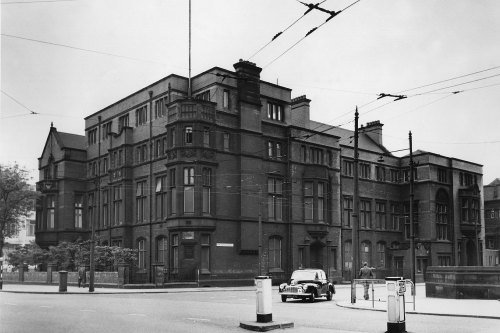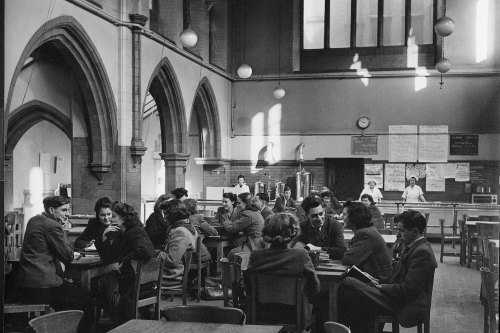The old Students' Union
The original Students' Union was built in 1895 to house the Men's Union and the Women's Union. The two unions merged when a replacement union building opened nearby in 1957.

The original building was on the site of the current Alan Gilbert Learning Commons. It was demolished in the 1950s to make way for a new refectory and student residence. The current Learning Commons building opened in 2012.
The Men’s Union originated in a discussion club, which expanded after 1861 to include a Debating Society and a range of subject-specific societies. It ran a clubhouse and later a magazine.
The Women’s Union began in 1900, after the men had refused to admit them. The women then leased a house on Oxford Road, at about the same time as Ashburne House (in Victoria Park) was formally opened as the first women’s residence. University students were part of the Votes for Women movement; the local leaders included the Pankhurst family; Christabel, the more radical of the daughters, was a Manchester graduate. Ellen Wilkinson, the future Labour minister of education, graduated in history in 1913 and became a suffrage organiser.
The original union building of 1909 housed both the Men’s and the Women’s Unions, back to back. It was near Oxford Road, with entrances on Burlington Street, for the men, and Lime Grove, for the women. Presidents of the Men’s Union were often graduates or on long professional courses, on which some enjoyed being students for as long as possible.
Anthony Burgess’s autobiography, Little Wilson and Big God, gives a good account of student life in the 1930s. It includes the excitement of working with the dramatist Joan Littlewood, who later became famous for the Theatre Workshop, and her Manchester partner, Ewan MacColl, later well known as a folk singer. John Burgess Wilson, as he then was, also wrote for The Serpent, the student magazine, contributing verse and critical articles as World War II approached.

The 1909 building was demolished in the late 1950s to make way for a staff and student refectory, connected with the Moberley Tower student residence. This complex was itself largely demolished after Project Unity in 2004 – all but a concrete frame, around which the Alan Gilbert Learning Commons was built and opened in 2013, remained.
The history of organised sport began with a college gym to the rear of the Quay Street building. The college colour, purple, was adopted before the move to Oxford Road, and the (men’s) Athletic Union was formed in 1885, including cricket, lacrosse, lawn tennis and rugby. But most of the students lived at home and many preferred to play for their local clubs, rather than the College. In 1900 the Firs Pavilion and Fallowfield Sports Ground was opened, and a women’s athletic union was begun, primarily for hockey. The athletic unions at Owens College and, later, the Victoria University of Manchester often shared facilities with students at Manchester Municipal College of Technology, later UMIST, now the north campus. For swimmers there was the McDougall Centre, about 100 metres to the west of the main campus, built as an equestrian centre but with a 25-metre pool from the 1920s and a gymnasium.
The Men and Women’s Unions remained separate until the mid-1950s, when Manchester was probably the last university segregated in this way. They merged to plan a new union building – the present home of the Students' Union – which was designed by John Somerville Beaumont in a modernist style, and opened in 1957. Anna Ford, later a well-known broadcaster, was the first woman to serve a full year as president of the joint union.
